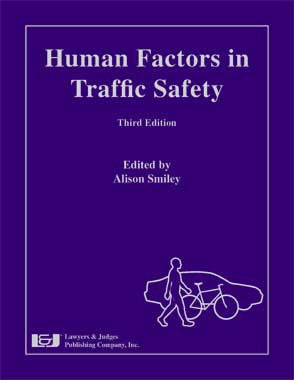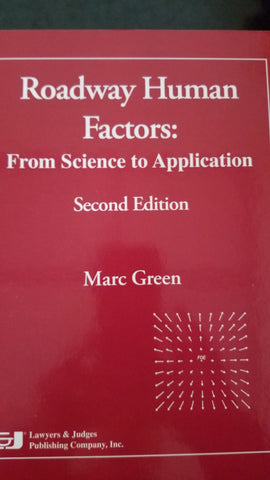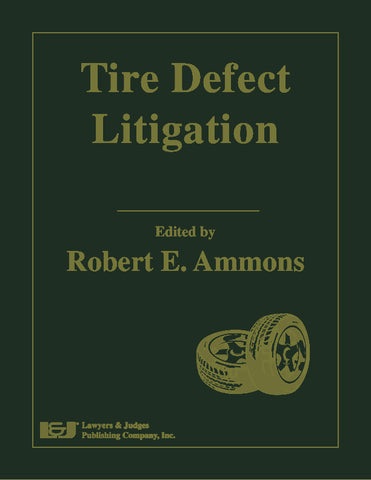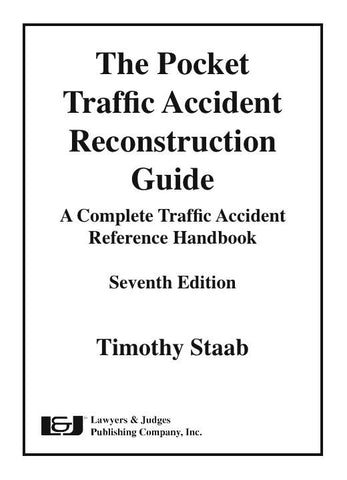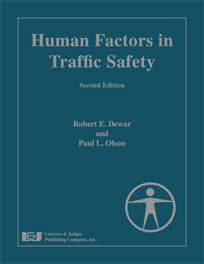
Human Factors in Traffic Safety, Second Edition
- Author: Robert E. Dewar, Paul L. Olson
- ISBN 10: 1-933264-24-1
- ISBN 13: 978-1-933264-24-0
- Copyright Date Ed: May 2, 2007
- Pages: 552 pages
- Binding Information: Paperback
- Size: 8.5 ✕ 11 Inches (US)
There are more than 175 million licensed drivers in the United States. Combined with the many pedestrians, bicyclists, motorcyclists, and other road users, this creates an interesting mix of elements with very different characteristics. Moving these elements efficiently and safely to their destinations presents a major challenge, particularly in densely populated areas. This book will provide guidance in how to identify these elements in your collision investigations. The authors introduce you to the ways in which designers of vehicles and roadways historically often did not take into account the full range of road user characteristics. The book discusses the substantial improvements in design principles and standards achieved over the years due to the concerted effort by concerned individuals interested in roadway and vehicle design and its impact on traffic safety.
Most importantly, this book introduces you to the behavior of the road user. Driver limitations and driver or pedestrian error are the major factors in traffic accidents, contributing to about 90% of roadway crashes. Driver behavior, however, is often the most complex and yet least understood element in the roadway system. A wide variety of perspectives on human factors and driver behavior are covered ranging from the design of roads, vehicles and traffic control devices to emotional and motivational determinants of driver behavior. Many traffic safety experts have contributed to this book in order to give you a comprehensive introduction to human factors as it pertains to driver and pedestrian behavior and traffic safety. This new edition has been extensively revised, and contains new chapters on driver education and driver distraction. If you are involved with accident investigation or the promotion of traffic safety in any capacity, this book is an essential part of your library.
This book is also available as an eBook. Click here to purchase and download:
TOPICS INCLUDE
- The driving task
- Accident causation and remediation
- Perception and information processing
- Driver perception-response time
- Driver eye fixations
- Fatigue and driving
- Alcohol, drugs and medications
- Age differences of drivers
- Other individual differences of drivers
- Neuropsychological, medical, and psychiatric disorders affecting motor vehicle operations
- Driver distraction
- Driver education
- Vehicle design
- Visibility with motor vehicle headlamps and under roadway lighting
- The roadway environment
- Roadway design
- Traffic control devices
- Environmental factors
- Railroad grade crossing accidents
- Work zone accidents
- Pedestrians, bicyclists, and other types of motorized and non-motorized vehicles
- Left turn and gap acceptance crashes
- Single-vehicle accidents
- Eyewitness reliability: The cognitive psychology of human memory
- Human factors in traffic accident litigation
Table of Contents
Chapter 1: Introduction
1.1 Human Factors
1.2 The Driving Task
1.3 System Elements
1.4 The Investigation of Motor Vehicle Accidents 6
Part I: The Driver
Chapter 2: Perception and Information Processing
2.1 Introduction
2.2 Perception
2.3 Perception of the Road
2.4 Visual Search
2.5 The Perception of Speed
2.6 Car Following
2.7 Rear-end Collisions.
2.8 Auditory and Other Sensory Information
2.9 Information Processing and Accidents
2.10 Driver Attention and Workload
2.11 Steering
2.12 Positive Guidance
Chapter 3: Driver Perception-Response Time
3.1 Introduction
3.2 Background
3.3 Human Perception-Response Time
3.4 Decision Sight Distance
3.5 Overview of Research
3.6 Factors Affecting Perception-Response Time
3.7 Special Situations
3.8 Summary and Conclusions
Chapter 4: Where Do Drivers Look While Driving (and for How Long)?
4.1 How Is Glance Behavior Described?
4.2 Why Are Eye Fixations of Interest?
4.3 What Is Typical Looking Behavior?
4.4 How Is Glance Behavior Affected by the Road Environment?
4.5 How Does Glance Behavior Change with Driver Characteristics?
4.6 What Is the Impact of Vehicle Characteristics on Glance Behavior?
4.7 How Might In-Vehicle Devices Impact Driving?
4.8 Conclusions
4.9 A Final Thought
Chapter 5: Individual Differences
5.1 Introduction
5.2 Personality
5.3 Emotions
5.4 Impact on Victims and Families
5.5 Stress
5.6 Aggressive Driving and "Road Rage"
5.7 Motivation
5.8 Risk Taking
5.9 Self-Assessment of Driving Skills
5.10 Behavioral Compensation
5.11 Social Factors
5.12 Driver Attitudes
5.13 Gender Differences
5.14 Driving Experience
5.15 Physical Factors and Motor Skills
5.16 Conclusions
Chapter 6: Fatigue and Driving
6.1 Introduction
6.2 Long Hours
6.3 Time of day
6.4 Inadequate Sleep
6.5 Countermeasures to Sleepiness
6.6 Conclusion
Chapter 7: Alcohol and Drugs
7.1 Introduction
7.2 Alcohol Use While Driving
7.3 Alcohol and Accidents
7.4 Single Vehicle Collisions
7.5 Measures of Intoxication
7.6 Driving Abilities Impaired by Alcohol
7.7 Rate of Alcohol Consumption
7.8 Alcohol and Fatigue
7.9 Alcohol and Aggression
7.10 Alcohol and Degree of Injury
7.11 Drug Effects
Chapter 8: Age Differences-Drivers Young and Old
8.1 Older Drivers
8.2 Young Drivers
8.3 Conclusion
Chapter 9: Neuropsychological, Medical and Psychiatric Disorders and Motor Vehicle Operations
9.1 Our Right to Drive and Our Right to be Safe: Two Competing Interests
9.2 Regulatory and Legal Factors Relating to Disability and Automobile Driving
9.3 The Americans with Disability Act and Constitutional Analysis
9.4 Failure to Warn and the Special Relationship of Healthcare Providers
9.5 Risk Assessment, Risk Communication, and Risk Management
9.6 Accident Risk Associated With Neuropsychological and General Medical Disorders
9.7 Adaptive Driving Programs And Medical Decisions
9.8 Assessment Issues
9.9 Conclusions
9.10 Agencies of Interest
Chapter 10: Driver Distraction
10.1 Introduction
10.2 Definitions of Driver Distraction
10.3 What is the Scope of the Driver Distraction Problem?
10.4 Cell Phones and Driving
10.5 Other In-Vehicle Distractions
10.6 External Distractions
10.7 Countermeasures for Driver Distraction
10.8 Conclusions
Chapter 11: Driver Education, Training, and Licensing
11.1 Introduction
11.2 Background
11.3 Traditional Driver Education
11.4 What We Know
11.5 Perception and Cognition
11.6 Language
11.7 Graduated Driver Licensing (GDL)
11.8 Parental Involvement
11.9 New Directions
11.10 The Paradigmatic Shift
11.11 Conclusion
Part II: The Vehicle
Chapter 12: Vehicle Design
12.1 Introduction
12.2 Requirements of the Driving Task
12.3 Anthropometry
12.4 Controls
12.5 Displays
12.6 Visibility from Within the Vehicle
12.7 Visibility of Other Vehicles
A. Daytime-running lights
B. Emergency vehicles
12.8 Trucks
12.9 Traffic Control Devices Relevant to Truck Operators
12.10 Motorcycles
12.11 Agricultural Vehicles
12.12 All-Terrain Vehicles
12.13 Vehicle Size and Safety
12.14 Safety Belts
12.15 Antilock Brake Systems
12.16 In-Vehicle Information Systems (IVIS)
12.17 Noise
12.18 Vibration
12.19 Older Drivers
12.20 Driving Vehicles of the Future
12.21 Conclusion
Chapter 13: Visibility with Motor Vehicle Headlamps
13.1 Introduction
13.2 The Importance of Target Contrast
13.3 The Reflectivity of Objects in the Real World
13.4 Driver Vision at Night
13.5 Nighttime Driving Speeds
13.6 Overdriving of Headlamps
13.7 Overview
Part III: The Roadway Environment
Chapter 14: Roadway Design
14.1 Introduction
14.2 Perception of the Road
14.3 Highway Hypnosis
14.4 Driver Workload and Roadway Design
14.5 Sight Distance
14.6 Roadway Width
14.7 Grades
14.8 Intersections
14.9 Bridges
14.10 Roundabouts
14.11 Curves
14.12 Rural Roads
14.13 Safety Countermeasures
14.14 Road Design and Accident Litigation
14.15 Conclusion
Chapter 15: Traffic Control Devices
15.1 Introduction
15.2 Criteria for Effective TCDs
15.3 Problems with TCDs
15.4 Signs
15.5 Signals
15.6 Pavement Markings
15.7 Rumble Strips and Speed Bumps
15.8 Post Delineators
15.9 Supplemental Warning Information
15.10 Environmental Factors
15.11 Aging and TCD Effectiveness
15.12 Cross-Cultural Comprehension of TCDs
15.13 Compliance with Traffic Control Devices
15.14 Methods for the Evaluation of TCDs
15.15 Conclusion
Chapter 16: Visibility Under Roadway Lighting
16.1 Introduction
16.2 Definitions and Concepts
16.3 Performance of Roadway Lighting
16.4 History of Criteria and Standards for Roadway Lighting
16.5 Types of Roadway Lighting
16.6 Methods for Assessing Roadway Lighting
16.7 Summary
Chapter 17: Environmental Factors
17.1 Introduction
17.2 The Hours of Darkness
17.3 Twilight
17.4 Adverse Weather
17.5 Effects of Restricted Visibility
17.6 Driver Behavior in Fog
17.7 Conclusion
Chapter 18: Railroad Grade Crossing Accidents
18.1 Introduction
18.2 The Accident Picture
18.3 Driver Behavior at Grade Crossings
18.4 Driver Perception of Railroad Crossing Hazards
18.5 Decision Errors
18.6 Attempting to "Beat the Train" Across the Tracks
18.7 Traffic Control Devices
18.8 Pedestrian Safety
18.9 Countermeasures
18.10 Conclusion
Chapter 19: Highway Work Zones
19.1 Human Factors and Work Zones
19.2 Accidents in Work Zones
A. Problems with accident data
B. The accident picture
19.3 Driver Information in Work Zones
19.4 Speed Selection and Control
19.5 Nighttime Conditions
19.6 Driver Behavior and Opinions
19.7 Older Drivers
19.8 Pedestrians in Work Zones
19.9 Trucks in Work Zones
19.10 Lane and Shoulder Width
19.11 Traffic Control Devices
19.12 ITS Applications in Work Zones
19.13 Safety Countermeasures
19.14 Conclusions
Part IV: Accident Causation and Remediation
Chapter 20: Pedestrians and Bicyclists
20.1 Pedestrian Safety
20.2 The Pedestrian's Task
20.3 Pedestrian Accidents
20.4 Driver and Pedestrian Behavior
20.5 Distracted Pedestrians
20.6 Alcohol Use
20.7 Left-turning Accidents
20.8 Walking Speed
20.9 Disabled Pedestrians
20.10 Older Pedestrians
20.11 Child Pedestrians
20.12 Nighttime Conditions
20.13 Winter Conditions
20.14 Social Factors
20.15 Roadway Design
20.16 Pedestrian Signs, Signals, and Markings
20.17 Intelligent Transportation Systems and Pedestrian Safety
20.18 Safety Countermeasures
20.19 Bicycle Safety
20.20 Cyclists' Perception of Risk
20.21 Cyclists' Behavior
20.22 Older Cyclists
20.23 Road and Environment Factors
20.24 ITS and Bicycle Safety
20.25 Other Non-motorized Transportation Modes
20.26 Conclusion
Chapter 21: Left-Turn and Gap Acceptance Crashes
21.1 Introduction
21.2 Definitions and Task Analysis
21.3 Left-turn Crash Patterns
21.4 Gap Acceptance Crash Patterns
21.5 Motorcycles, Small Vehicles, Bicycles, and Pedestrians
21.6 Age Differences in Left-turn and Gap Acceptance Crashes
21.7 Driver Citations and Error
21.8 Left Turn Driving Simulation and Field Studies
21.9 Gap Acceptance Studies
21.10 Perception of Oncoming and Cross Traffic
21.11 Signals and Intersection Design
21.12 Conclusions
Chapter 22: Single-Vehicle Accidents
22.1 Introduction
22.2 Characteristics
22.3 Suicide?
22.4 Remedial Measures
22.5 Summary
Chapter 23: Eyewitnesses to Accidents: The Factors that Determine Accuracy
23.1 Introduction
23.2 Observing and Encoding Events into Memory
23.3 Retaining the Memory for Observed Events
23.4 Forgetting of Memory
23.5 How to Improve Recall
23.6 Memory for Everyday and Unusual Events Differs in Accuracy
23.7 Do Some People Have Better Memories than Others?
23.8 The Surprising Lack of a Relationship between Confidence and Accuracy
23.9 When Are Two Witnesses Better than One?
23.10 Summary
Chapter 24: Human Factors in Traffic Accident Litigation
24.1 Introduction
24.2 The Profession
24.3 Hazards in Vehicle Operation
24.4 Designing for Whom?
24.5 Admissibility of Evidence from a Human Factors Expert
24.6 What the Human Factors Expert has to Offer the Lawyer
24.7 Locating Suitably Qualified Human Factors Experts

